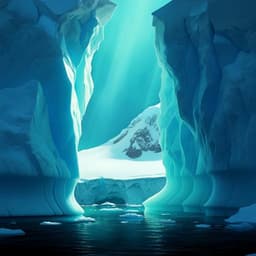
Earth Sciences
Seawater oxygen isotopes as a tool for monitoring future meltwater from the Antarctic ice-sheet
H. Kim and A. Timmermann
This research by Hyuna Kim and Axel Timmermann explores the promising role of seawater oxygen isotopes in monitoring Antarctic ice-sheet freshwater discharge and its impact on sea level rise. With findings indicating that isotope signals can provide earlier warnings than traditional salinity measures, this study highlights the need for continuous δ¹⁸Osw measurements to safeguard against rapid ice-sheet loss.
~3 min • Beginner • English
Introduction
Antarctica is Earth’s largest freshwater reservoir, and future melting of its glaciers and ice sheet will raise global sea level. Ice-sheet freshwater discharge (IFD) into the Southern Ocean can reduce bottom-water formation and increase sea-ice cover, driving subsurface warming, surface cooling, and atmospheric circulation changes that affect nutrients and productivity. Coupled climate–ice-sheet feedbacks may also delay Southern Hemisphere warming, underscoring the need to benchmark next-generation Earth system models with reliable observational datasets of Antarctic IFD. While satellite and airborne remote sensing provide key large-scale constraints, direct in situ observations (e.g., δ18O of seawater, noble gases, CTD) remain spatially and temporally sparse, and there is no large-scale ocean monitoring system that directly quantifies IFD and distinguishes it from other freshwater sources. Because Rayleigh distillation depletes precipitation over Antarctica in heavy isotopes, Antarctic ice is isotopically light relative to seawater. Its melt introduces a negative anomaly in seawater δ18O (δ18Osw). Sea-ice freezing/melting imprints only a small effect on δ18Osw but a large one on salinity, whereas precipitation and runoff affect both. The study tests the hypothesis that δ18Osw is a superior tracer of anthropogenic IFD compared to salinity by forcing an isotope-enabled climate model with projected IFD and evaluating time of emergence relative to natural variability.
Literature Review
Prior work documents accelerating Antarctic mass loss and grounding-line retreat, impacts of IFD on sea-ice and Southern Ocean circulation, and the importance of coupled ice–ocean–atmosphere feedbacks for climate and sea-level projections. Observational campaigns (satellite altimetry, gravimetry, interferometry) and local ocean tracers (e.g., seawater δ18O, noble gases) have revealed IFD signals, but coverage is limited. Classical isotope theory (Craig–Gordon, Dansgaard) explains isotopic depletion over Antarctica. Sea-ice processes fractionate isotopes weakly compared to IFD and precipitation. Modeling studies show that Antarctic meltwater can alter ocean circulation and climate. These lines of evidence motivate using δ18Osw as a robust IFD monitor distinct from salinity, which is confounded by precipitation and sea-ice variability.
Methodology
An isotope-enabled Community Earth System Model (iCESM v1.2.2; ~2° atmosphere, ~1° ocean) was used. A 1000-year control (CTR) with present-day conditions established natural variability. Freshwater perturbation experiments applied time-varying IFD from the fully coupled LOVECLIP climate–ice-sheet model under three scenarios: FWF119 (SSP1-1.9), FWF245 (SSP2-4.5), and FWF-GHG585 (SSP5-8.5). FWF119 and FWF245 applied only IFD with δ18Oice = −32‰, without increasing greenhouse gases, to isolate IFD impacts; FWF-GHG585 applied both increasing GHGs and IFD with δ18Oice = −32‰. An additional paired experiment FWF0-GHG585 used identical forcings but set δ18Oice = 0‰ to isolate climate-only effects (precipitation, sea ice) on δ18Osw by differencing with FWF-GHG585. Spatial distribution of IFD forcing was derived from LOVECLIP’s net IFD fields (basal melt, cliff/face melt, iceberg calving) by an EOF-based weighting (PC1–PC3 sum accounting for 68% variance) applied monthly over 2001–2100 CE. The representative δ18Oice for Antarctic IFD (−32‰) was estimated from ice-core datasets (Siple Dome, Gomez, Byrd, Taylor Dome, Talos Dome) by averaging the lowest 200 m and computing a regional mass-balance-weighted mean. Budget analyses using CTR quantified contributions of precipitation minus evaporation (PME), liquid runoff (mostly snowcap melt), and sea ice to mixed-layer δ18Osw and salinity by normalizing freshwater fluxes by mixed-layer depth and multiplying by source δ18O and salinity contrasts. Time of emergence (ToE) was defined per grid cell as the final year when annual mean δ18Osw or SSS anomaly fell below the local 4σ threshold of the 100-year CTR, exploring thresholds from 1–4σ and adopting 4σ for robustness. Signal-to-noise ratios (SNRs) for intra-seasonal and interannual variability used CTR statistics; the IFD signal used 2076–2085 anomalies from FWF-GHG585. Natural variability in SSS and sea ice was evaluated against ORAS5 reanalysis (1979–2018), confirming realistic amplitude and spatial patterns, with a ~0.5 psu mean salinity bias but comparable interannual variability. Analytical detectability considerations included typical δ18Osw measurement precisions for IRMS (~0.03‰) and CRDS (~0.1‰ continuous; ~0.025‰ discrete).
Key Findings
- δ18Osw provides a much stronger and earlier signal of Antarctic IFD than salinity. The δ18Osw IFD anomaly exhibits an average SNR (90°S–60°S) roughly three times higher than that of SSS, implying earlier detectability.
- Spatial patterns: strongest late-21st-century anomalies occur in the Ross Sea, with signals advected into the Pacific sector via the ACC; weaker signals in the Weddell Sea due to dilution, variability, and circulation divergence.
- Time of emergence (ToE): δ18Osw ToE occurs broadly earlier than SSS. In the Ross Sea, δ18Osw emerges around 2010–2020 CE even for low forcing (FWF119) and earlier/more widespread under FWF245 and FWF-GHG585 (2010–2045 CE), including early emergence near the ACC (~60°S). In a representative Pacific sector location, δ18Osw ToE ~2030 CE under FWF245 and FWF-GHG585; the corresponding SSS ToE in FWF-GHG585 is ~2066 CE, i.e., 36 years later.
- Magnitude and detectability: δ18Osw anomalies reach <−0.6‰ over the next six decades in key regions, resolvable with CRDS/IRMS precision. Phase-averaged δ18Osw anomalies for 90°S–70°S are −0.17, −0.24, −0.32, −0.41, and −0.97‰ for phases centered on 2010, 2020, 2030, 2040, and 2050, respectively.
- Source vs climate contributions: Paired experiments indicate that IFD accounts for about 10%, 61%, 72%, and 83% of the δ18Osw change in phases A (2001–2005), B (2031–2035), C (2051–2055), and D (2076–2080), respectively. Climate-only effects (precipitation/sea-ice changes and warming) contribute less than 17% to net δ18Osw change by late century in FWF0-GHG585.
- Freshwater source budgets (CTR): Mean contributions over 90°S–60°S to mixed-layer δ18Osw are −0.05‰ yr−1 (PME), −0.04‰ yr−1 (liquid runoff), and −0.04‰ yr−1 (sea ice). Corresponding salinity impacts are −0.10, −0.07, and −0.10 psu yr−1. Sea ice strongly affects salinity (~39% of salinity budget) but less so δ18Osw (~32%), while IFD induces a disproportionately large δ18Osw signal due to very depleted δ18Oice (~−32‰).
- Sensitivity to δ18Oice: Varying δ18Oice between −38‰ and −32‰ has little effect on ToE; for less depleted values (e.g., −15‰ to −25‰) ToE is delayed, by up to ~6 decades for −15‰, with effective detection maintained for ≤−25‰.
- Subsurface imprint: Emergent δ18Osw anomalies propagate into subducted Antarctic Intermediate Water; enhanced stratification and reduced AABW formation modulate vertical transport, leaving characteristic depth anomalies (200–1000 m).
Discussion
The study addresses how best to monitor Antarctic ice-sheet freshwater discharge by demonstrating that seawater δ18Osw offers a clearer, earlier, and more specific signal of IFD than salinity. Because sea-ice processes disproportionately influence salinity and only weakly affect δ18Osw, and because precipitation-driven δ18O changes are comparatively small near the coast, δ18Osw isolates the IFD signal with higher SNR. Model experiments show early emergence in the Ross Sea and along the Pacific sector, providing practical guidance for targeted observations. The findings suggest that sustained δ18Osw monitoring can serve as an early warning for accelerated Antarctic mass loss, enabling earlier detection (by decades) than salinity-based indicators and improving constraints on sea-level rise projections. The persistently large IFD contribution to δ18Osw even under greenhouse warming indicates robustness against confounding climate effects, while subsurface signals in AAIW present additional opportunities to reconstruct IFD history and pathways.
Conclusion
Seawater oxygen isotopes (δ18Osw) outperform salinity as an indicator of Antarctic ice-sheet freshwater discharge, with earlier time of emergence, higher signal-to-noise ratio, and limited contamination by sea-ice processes. Model projections indicate that δ18Osw anomalies associated with IFD have already emerged in the Ross Sea since around 2020 CE and will be widely detectable with current analytical precision. Toward century’s end, direct IFD source effects dominate δ18Osw changes (up to ~83%), supporting δ18Osw as a practical tool for early detection and monitoring of Antarctic mass loss and for improving sea-level projections. Future work should deploy continuous CRDS-based underway δ18Osw measurements in the Ross–Amundsen–Antarctic Peninsula sector (poleward of ~70°S), expand to subsurface sampling (AAIW), and integrate δ18Osw with other tracers (e.g., 14C, CFCs, δD). Next-generation fully coupled climate–ice-sheet models with explicit iceberg and basal melt processes and refined δ18Oice distributions will further constrain detection thresholds, source attribution, and regional transport.
Limitations
- Model configuration limitations: iCESM lacks an interactive ice-sheet/ice-shelf/iceberg component and does not explicitly simulate sub–ice-shelf cavity melting or iceberg melt, which can affect freshwater pathways, sea-ice evolution, and local temperatures.
- Forcing uncertainties: IFD magnitude and spatial pattern are taken from LOVECLIP (lower-resolution, intermediate complexity), introducing scenario and structural uncertainty.
- Source isotopic composition: While δ18Oice ≈ −32‰ is constrained by ice cores, regional variability and time evolution introduce uncertainty; less depleted source values would delay detectability.
- Natural variability representation: Biases and uncertainties in modeled SSS, sea ice, and δ18Osw variability (though evaluated against ORAS5) affect SNR and ToE estimates.
- Forcing omissions/simplifications: Aerosols and land-use changes were not included in SSP5-8.5 forcing; salinity bias (~0.5 psu) exists relative to ORAS5.
- Observational constraints: Present δ18Osw datasets have limited spatial/temporal coverage; recommended CRDS deployment strategies will be needed to operationalize detection.
Related Publications
Explore these studies to deepen your understanding of the subject.







